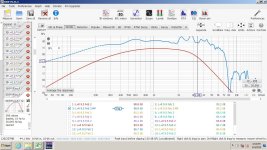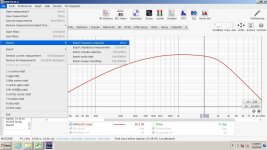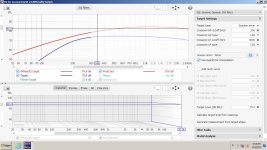Final recommendation:"
Build your filters (the digital crossover if you will) in the filter section of HFD.
Use the EQ section to add room correction and voicing changes. It's easy to keep track of what is a driver level correction, vs making the whole speaker sound different for whatever reason.
Version control, version control, version control. When you make a changes to a filter design, save it as a new project. (PROJECTv1, PROJECTv2, etc)
That way you can always revert back to a previous version if you get lost after changing a bunch of stuff.
Build your filters (the digital crossover if you will) in the filter section of HFD.
Use the EQ section to add room correction and voicing changes. It's easy to keep track of what is a driver level correction, vs making the whole speaker sound different for whatever reason.
Version control, version control, version control. When you make a changes to a filter design, save it as a new project. (PROJECTv1, PROJECTv2, etc)
That way you can always revert back to a previous version if you get lost after changing a bunch of stuff.
I was able to make a target response using PCD. It's simple to import an frd into REW. Here's a target, and a raw woofer measurement to use as an example. Basically, I would add filters to shape the woofer response to match the target. So maybe to start I'd select a 1st order filter on both high-pass, and low-pass, and see what it looks like. Second adjustment would probably be reducing the gain 3 or 4dB. Then adjust from there. Odds are in this example, neither the high, or the low-pass filters would not be a 4th order, which is what the other suggested method might suggest. The other methods may also be excellent. (I didn't read them all. ) I'm just pointing out a different way of doing things.
Now that I have learned how to do this target for REW, I may use it with my trial and error passive x-overs on occasion.
Now that I have learned how to do this target for REW, I may use it with my trial and error passive x-overs on occasion.
Attachments
Last edited:
I think REW can calculate filters to match a target for sub-woofers, and probably mids, and tweeters as well. I don't know how to do that though. Someone here probably knows. I know a guy on another rforum that might know. I'll check with him.
Just to make sure I understand correctly: I create (not sure how) an arbitrary target response curve and import it into REW. REW will assume it is a free-space response target and will generate a set of filters that will modify a previously measured response to match the target as close as as it can. Then implement these filters in HFD and hope the response will also match the target. Right?
I am not sure what frd is. Is it a text(?) file with a dB response value per frequency? so I could just type one up? or is it smth else?
I am not sure what frd is. Is it a text(?) file with a dB response value per frequency? so I could just type one up? or is it smth else?
This done step-by-step works.
https://kimmosaunisto.net/Software/VituixCAD/VituixCAD_Measurement_REW.pdf
It is not the all necessary steps, but most of them. Also you will need some extra internal VituixCAD tools.
https://kimmosaunisto.net/Software/VituixCAD/VituixCAD_Measurement_REW.pdf
It is not the all necessary steps, but most of them. Also you will need some extra internal VituixCAD tools.
I sent a PM to someone who knows REW much better than me. I made my above posted target using PCD. I'm not sure if REW will match that target, but there is a section in REW that appears to be made for doing targets.I'm pretty sure the subwoofer guys do this to match a room bass target. This is under the EQ tab in REW. It's probably easy once someone tells you how. I've not attempted to use the feature.
Attachments
For those of you have been through this process: Why did you choose not to do any of the measurements right in HFD? I've got a Hypex project that is a bit further along (I have a set of functioning filters, and I've been listening for about a month or so to look for things I don't like, with plans to go back and make some tweaks), and I also used REW. My reason was I have a USB mic, which don't appear to be directly supported by HFD, so I just fell back on using REW, but if I had a different mic that would have worked, I probably would have given it a shot. Wondering if anyone tried it and got bad results.
I couldn't get HFD measurements to work.
Once I started playing with FIR filters, it became a moot point anyways.
Once I started playing with FIR filters, it became a moot point anyways.
Same, only USB-mic. I was familiar with REW and minidsp. I have so far set up three pairs of 3-way way speakers with Hypex FAxxx.
I don't know if it is possible to save and overlay several measurements in HFD... I want to compare responses before and after changing settings and do tens of iterations. And I haven't even tried to let REW to calculate settings.
HFD is much more clumsy than minidsp sw, and settings don't go directly to the board.
I don't know if it is possible to save and overlay several measurements in HFD... I want to compare responses before and after changing settings and do tens of iterations. And I haven't even tried to let REW to calculate settings.
HFD is much more clumsy than minidsp sw, and settings don't go directly to the board.
The way I suggested would take lots of sweeps but should be relatively easy. You might even want to consider a hybrid x-over. For example on the tweeter, you could have a quality 10uf cap as part of the filtering. This would also protect the tweeter should the active filter accidentally be changed. A cap on the mid could protect the mid, and possibly reduce system noise from the electronics. I'm just guessing on that one, although I remember a thread where padding was needed on a big high sensitivity tweeter driver to reduce audible hiss. Woofer breakup could be dealt with using a tank filter.
Now that the wood cutting is done, I have checked the estimates for MF and LF chamber net volumes (accounting for drives and bracing):
MF is 4.2L, before any bitumen or foam is added. This leaves plenty of volume for adding foam. Which is good for absorbing internal reflections.
LF is 9.4L. I may or may not want to add anything e.g. a weight at the bottom for stability. I may or may not have to reduce the volume for acoustic response reasons (modelled vol is about 6L - the drives are very stiff!).
So, I seem to have enough flexibility.
Wood glue arriving tomorrow, sanding tool and weights ready to start glueing.
MF is 4.2L, before any bitumen or foam is added. This leaves plenty of volume for adding foam. Which is good for absorbing internal reflections.
LF is 9.4L. I may or may not want to add anything e.g. a weight at the bottom for stability. I may or may not have to reduce the volume for acoustic response reasons (modelled vol is about 6L - the drives are very stiff!).
So, I seem to have enough flexibility.
Wood glue arriving tomorrow, sanding tool and weights ready to start glueing.
Last edited:
Marty sent me this for using REW to make filters. I've butchered it trying to copy, and paste, but here's the reply.
Yes, but it depends on what filter results you want, such as for a specific DSP or just generic filters, etc.
With your measurement loaded and selected active,click the EQ icon:

Right side, start with generic or select the DSP you're going to use these with so it generates filters that are useful. Your choice. Lots of choices here.

Usually you see people use this for subwoofers and house curves, but it has a full suite for full range drivers. Select the type, which really just enables bandpasses for use:

If you do a speaker, it will have new parameters with crossovers:

If you do a full range, it will have different options (less):

Then the typical tools to effect which bandpass and slopes:

Then tell it what range to effect and how much boosting or cutting, etc.

Match.
Then save.
Very best,
~Marty



Yes, but it depends on what filter results you want, such as for a specific DSP or just generic filters, etc.
With your measurement loaded and selected active,click the EQ icon:

Right side, start with generic or select the DSP you're going to use these with so it generates filters that are useful. Your choice. Lots of choices here.

Usually you see people use this for subwoofers and house curves, but it has a full suite for full range drivers. Select the type, which really just enables bandpasses for use:

If you do a speaker, it will have new parameters with crossovers:

If you do a full range, it will have different options (less):

Then the typical tools to effect which bandpass and slopes:

Then tell it what range to effect and how much boosting or cutting, etc.

Match.
Then save.
Very best,
~Marty
Just an educated guess, but if I was adding weight, I probably would add it about a third of the way up from the bottomNow that the wood cutting is done, I have checked the estimates for MF and LF chamber net volumes (accounting for drives and bracing):
MF is 4.2L, before any bitumen or foam is added. This leaves plenty of volume for adding foam. Which is good for absorbing internal reflections.
LF is 9.4L. I may or may not want to add anything e.g. a weight at the bottom for stability. I may or may not have to reduce the volume for acoustic response reasons (modelled vol is about 6L).
So, I seem to have enough flexibility.
Wood glue arriving tomorrow, sanding tool and weights ready to start glueing.
Why?
I am considering weight for stability, so the very bottom would make most sense.
If you are thinking for acoustic reasons, I do not meed any. The cabinet will be extremely heavily braced and will be very heavy for the size (15kg+?). And anyhow, the main requirement for the LF chamber is high stiffness (high resonance f, outside its working band) not high weight (low resonance f).
I am considering weight for stability, so the very bottom would make most sense.
If you are thinking for acoustic reasons, I do not meed any. The cabinet will be extremely heavily braced and will be very heavy for the size (15kg+?). And anyhow, the main requirement for the LF chamber is high stiffness (high resonance f, outside its working band) not high weight (low resonance f).
Last edited:
I know, for you it may seem silly, trivial, but I would like to know what program you are using for all these things you are showing.
tell me come on 🙂
tell me come on 🙂
Just to add mass directly behind the woofers so that the box might move less from the woofers shaking the box. For tip over stability, I agree that lower is better.Why?
I am considering weight for stability, so the very bottom would make most sense.
If you are thinking for acoustic reasons, I do not meed any. The cabinet will be extremely heavily braced and will be very heavy for the size (15kg+?). And anyhow, the main requirement for the LF chamber is high stiffness (high resonance f, outside its working band) not high weight (low resonance f).
I see what you mean now.Just to add mass directly behind the woofers so that the box might move less from the woofers shaking the box. For tip over stability, I agree that lower is better.
Each bass driver is 4kg, so with the box and amp it will be about 20kg+ per speaker. The back wall will be 31mm Valchromat. I may add bitumen on walls instead of a bottom weight.
- Home
- Loudspeakers
- Multi-Way
- 3-way to active - Hypex FA253 - learning project


